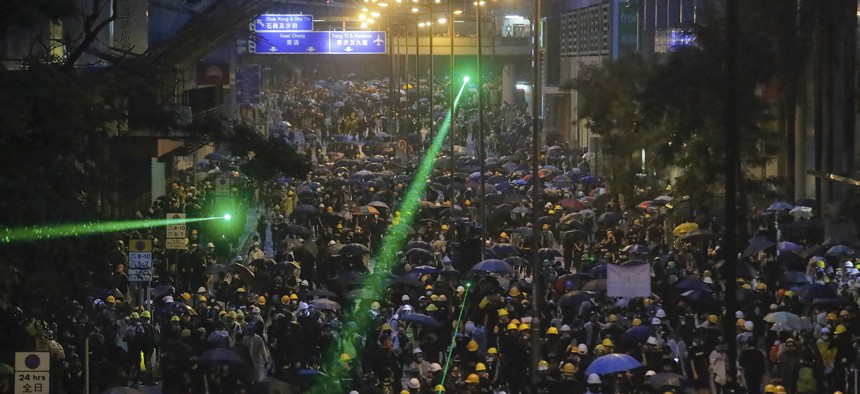How Chilean Protesters Took Down a Drone With Standard Laser Pointers

Demonstrators, some using laser pointers toward police lines during a protest in Hong Kong, Sunday, Aug. 25, 2019. Kin Cheung/AP
The low-powered presentation tool/dangerous children’s toy is becoming a weapon of choice for protesters around the world trying to take down or disable surveillance tech.
Video of Chilean protesters using beams of green light to ground a police drone made the rounds on social media Wednesday. But those aren’t tractor beams or Green Lantern rings—the protesters appear to be using run-of-the-mill laser pointers to take down law enforcement-grade technology. How does that work?
Chilean protesters took to the streets last month to speak out against a proposed increase in public transit fares, though the demonstrations have now turned into a countrywide expression of anger over low wages and inequality.
Video posted to Reddit late Tuesday appears to show training laser pointer pens on a police drone in an attempt to bring it to the ground. As more light beams make contact with the unmanned aerial system, or UAS, it falters, then almost escapes before a coordinated effort brings it slowly to Earth.
The laser pointers could have taken down the drone in the video in one of two ways, according to Christopher Williams, CEO of Citadel Defense Company, which is working with Customs and Border Protection to deploy anti-drone “bubbles” along the border.
If the drone was being flown manually by an operator watching through a first-person video, the bright lights might have blinded the camera, causing the operator to lose control. Alternatively, “low powered lasers have the ability to interfere with [infrared] landing sensors,” as well as the downward-facing cameras that detect obstacles below, “forcing a landing or uncontrolled drone behavior,” Williams said.
Commentators on Reddit offered a third possibility: that the combined heat from all those laser pointers was enough to melt internal wiring or cause the battery to give out.
Beyond drones, laser pointers are fast becoming the tool of choice for protesters around the world. In Hong Kong, people in the streets are using laser pointers to mess with facial recognition and other surveillance technologies.
While effective for grassroots purposes, Williams said he does not believe low-powered lasers like these will become widely adopted as counter-drone measures.
“Use of these types of lasers is more hazardous and disruptive to humans than it will be for drones,” he said. “There are many other technologies that are less disruptive that provide a superior, more scalable, more reliable and more cost-effective countermeasure.”
That said, high-powered lasers are certainly being developed to destroy or otherwise knock drones out of the air. Just last month, the Raytheon delivered the Air Force a high-powered laser to down drones. Rather than scrambling sensors or blinding operators, the high-powered versions turn up the heat, melting a drone’s components or internal wiring or causing batteries to explode.
Raytheon declined to comment for this story.
The Air Force isn’t the only military branch looking at lasers for counter-drone technology. The Army Fires Battle Lab has been developing an experimental program called the Mobile High-Energy Laser, or MEHEL, since 2017.
“The industry as a whole is focused on creating a menu of CUAS sensor options that can be adapted to different use cases and price points,” Williams said. “As the threat outpaces government responsiveness and legislative decision making, drone threats and less conventional countermeasures will continue to be an issue.”
NEXT STORY: Quantum Supremacy Is (Maybe) Here. Now What?






